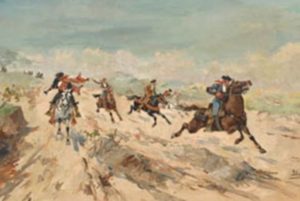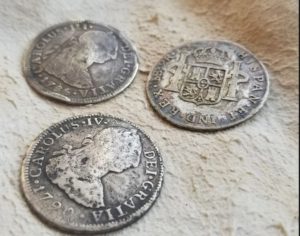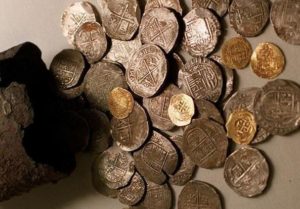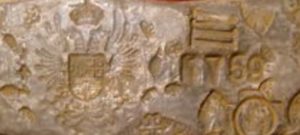Podcast: Play in new window | Download
Subscribe: Apple Podcasts | RSS
Many folktales, ballads and legends throughout Mexico tell of bandits amassing fortunes and hiding away their treasures. Some of these stories may not be tall tales at all. Following are three intriguing yarns of Mexican bandidos and their hidden loot.
- Vicente Colombo’s Treasure Tunnels
Vicente Colombo was a bandit who inhabited a region of Jalisco at the foot of the volcano known as Nevado de Colima, located on the border of the Mexican states of Colima and Jalisco. The legend of this man dates to colonial times. Colombo dedicated himself to robbing the families of the nearby towns who had made their fortunes illicitly either through smuggling or from illegal mining operations. Colombo was supported by a gang of bandits, and the money and jewels obtained from the robberies were hidden in a series of caves located near the base of the Nevado de Colima. During one of his expeditions to a wealthy section of a town, Colombo caught sight of a woman named Paula, who was the daughter of a well-known merchant. To him, it was love at first sight. Knowing that his status as a bandit would probably prohibit their ever meeting, Colombo forcibly entered Paula’s house and kidnapped her, taking her away to his bandit encampment near the slopes of the v olcano. Paula was kept against her will by the gang of thieves but she was treated like a queen, a queen in a golden cage, forced to live in one of the caves of the volcano. Colombo showered Paula with riches and although she lived in a cave, she had more comforts that she enjoyed while living in the house of her father, the wealthy merchant. After bearing Colombo a daughter whom they named María, Paula died of a rare disease. After Paula’s death the bandit raised the little girl with great care. As María grew up and started blossoming into a woman, other members of the group of bandits became interested in her. Colombo’s deep love for his daughter caused him to be overly protective of her as she grew older. One of the bandit troupe, Andrés Patiño, fell madly in love with María, a love that was impossible according to Colombo, because his daughter deserved another life, married to a good, respectable man. He looked for a way to integrate her into society without anyone knowing that she was the daughter of a bandido. Should he send her away to live with distant relatives in Mexico City? Colombo and Patiño fought over this situation and one day it came to a shootout with both men dying in the shooting. After this terrible incident, María ran away and the bandit band broke up. Some of the thieves took away the treasure that they knew about, but a great deal of loot was stashed by Vicente Colombo himself and no one knew where he hid it. Over the years many treasure hunters have tried to locate the gold and jewels of this band of bandits in the caves and tunnels of the Nevado de Colima but no one has discovered anything, or at least they’re not talking about it. It is said that whoever finds the treasure must take everything that is in the cave, otherwise he does not leave there alive.
olcano. Paula was kept against her will by the gang of thieves but she was treated like a queen, a queen in a golden cage, forced to live in one of the caves of the volcano. Colombo showered Paula with riches and although she lived in a cave, she had more comforts that she enjoyed while living in the house of her father, the wealthy merchant. After bearing Colombo a daughter whom they named María, Paula died of a rare disease. After Paula’s death the bandit raised the little girl with great care. As María grew up and started blossoming into a woman, other members of the group of bandits became interested in her. Colombo’s deep love for his daughter caused him to be overly protective of her as she grew older. One of the bandit troupe, Andrés Patiño, fell madly in love with María, a love that was impossible according to Colombo, because his daughter deserved another life, married to a good, respectable man. He looked for a way to integrate her into society without anyone knowing that she was the daughter of a bandido. Should he send her away to live with distant relatives in Mexico City? Colombo and Patiño fought over this situation and one day it came to a shootout with both men dying in the shooting. After this terrible incident, María ran away and the bandit band broke up. Some of the thieves took away the treasure that they knew about, but a great deal of loot was stashed by Vicente Colombo himself and no one knew where he hid it. Over the years many treasure hunters have tried to locate the gold and jewels of this band of bandits in the caves and tunnels of the Nevado de Colima but no one has discovered anything, or at least they’re not talking about it. It is said that whoever finds the treasure must take everything that is in the cave, otherwise he does not leave there alive.
- The Lost Treasure of Agapito Treviño
Agapito Treviño considered himself to be the Robin Hood of Monterrey. He was born in the year 1829 on the Hacienda de los Remates just outside the town of Guadalupe in the Mexican state of Nuevo León. At the age of 18 he was already a known thief throughout the area and terrorized the wealthy of Monterrey. In part, what made him so famous was his style of stealing from his marks: he would arrive riding a white horse, always carrying a harmonica. When assaulting his victims, he forced them to dance in their underwear while he played a melody, then he left them tied up. Despite his quirky sense of humor, he never killed anyone. In fact, he became loved by many people and considered himself “kind” since he did not resort to violence when he stole. At the  end of the day, this legendary thief carried bags full of the loot to distribute to the poorest people of the countryside. Agapito did not give away everything, however. He loved gold, diamonds and other precious gems, and he kept those for himself, hiding it all deep in the Cueva de La Boca, the home to thousands of bats. In the year 1851 the dandy thief was arrested for the first time. He was sentenced to 10 years of forced labor in the quarries of the Loma del Obispado, from which he escaped with everything including his shackles which were still on him securely. He was captured a second time in 1853 and again sentenced to another 10 years of forced labor in the construction of the Municipal Palace of Monterrey. Again, they could not contain him, and he ran away once more. The third and last time he was captured was in 1854. On this occasion he was sentenced to death. It was on July 24th in the Plaza Hidalgo in front of the Municipal Palace when he faced a firing squad at the age of 25. Even in his last moments, according to legend, he sang with the blindfold on: “Goodbye Monterrey, goodbye friends, forgive me if I hurt you.” Agapito Treviño’s fortune in gold and jewels is still hidden in the cave. Some locals say that the treasure is cursed and that the person who finds it will go crazy. Others say that the people who discover it and spend it on themselves will die a horrible death. The great treasure of Agapito Treviño remains lost, perhaps forever.
end of the day, this legendary thief carried bags full of the loot to distribute to the poorest people of the countryside. Agapito did not give away everything, however. He loved gold, diamonds and other precious gems, and he kept those for himself, hiding it all deep in the Cueva de La Boca, the home to thousands of bats. In the year 1851 the dandy thief was arrested for the first time. He was sentenced to 10 years of forced labor in the quarries of the Loma del Obispado, from which he escaped with everything including his shackles which were still on him securely. He was captured a second time in 1853 and again sentenced to another 10 years of forced labor in the construction of the Municipal Palace of Monterrey. Again, they could not contain him, and he ran away once more. The third and last time he was captured was in 1854. On this occasion he was sentenced to death. It was on July 24th in the Plaza Hidalgo in front of the Municipal Palace when he faced a firing squad at the age of 25. Even in his last moments, according to legend, he sang with the blindfold on: “Goodbye Monterrey, goodbye friends, forgive me if I hurt you.” Agapito Treviño’s fortune in gold and jewels is still hidden in the cave. Some locals say that the treasure is cursed and that the person who finds it will go crazy. Others say that the people who discover it and spend it on themselves will die a horrible death. The great treasure of Agapito Treviño remains lost, perhaps forever.
- The Devil and the Treasures of Zacatecas
About 50 miles northwest of Fresnillo a series of hills rise above the semi-arid plains. One of them is known among the locals as the Cerro el Xoconostle, also called Cerro Gordo. In the 1600s, common people became rich in the surrounding area through silver mining, and to a lesser extent, prospecting for gold. Fresnillo, known then as Real Minas del Fresnillo, was a place that offered infinite opportunities to enrich the lives of both miners and merchants, and many adventurers came from around the world to make their fortunes in the region. The gold and silver, melted into ingots, were transported in carts pulled by oxen. They traveled heavily guarded on the royal road until they reached the city of Zacatecas where they were deposited in the Caja Real, or royal  depository, and from there the “royal fifth” was sent to Spain. The riches that stayed with the miners in the area attracted bandits who terrorized the towns of the region which were devastated by their frequent raids. Eventually, the armed forces were quartered in the Fresnillo Presidio to help prevent robberies and other crimes committed against the miners and merchants. Although the military helped somewhat, they could not deter all the banditry in Zacatecas. To better safeguard their valuables, locals hid their treasures in caves that no one knew about. The perfect hiding spot for many was the Cerro el Xoconostle. In fact, no one approached that place because it was a very strange hill, and since before the Spanish arrived, the locals said, the devil has lived there. Penetrating and suffocating smells were emitted from the many caves in that small mountain. No grass grew in and around the cerro. The countryside nearby was dominated by thickets and thorny undergrowth that sprouted from the black earth. This hill, according to the indigenous people of the area, was the chimney of an ancient volcano that erupted thousands of years ago. The lizards and snakes that abound there are dark and with scaly skin and a horrifying sight that drives away the curious. All this was considered by the miners when deciding where to hide their fortunes. They believed that because the devil was assumed to have inhabited those caves, no one would dare to venture into them, much less try to take the treasure of the miners. Years passed and people began to forget what had been deposited in the hill, although vague rumors of fabulous riches at the Cerro el Xoconostle persisted.
depository, and from there the “royal fifth” was sent to Spain. The riches that stayed with the miners in the area attracted bandits who terrorized the towns of the region which were devastated by their frequent raids. Eventually, the armed forces were quartered in the Fresnillo Presidio to help prevent robberies and other crimes committed against the miners and merchants. Although the military helped somewhat, they could not deter all the banditry in Zacatecas. To better safeguard their valuables, locals hid their treasures in caves that no one knew about. The perfect hiding spot for many was the Cerro el Xoconostle. In fact, no one approached that place because it was a very strange hill, and since before the Spanish arrived, the locals said, the devil has lived there. Penetrating and suffocating smells were emitted from the many caves in that small mountain. No grass grew in and around the cerro. The countryside nearby was dominated by thickets and thorny undergrowth that sprouted from the black earth. This hill, according to the indigenous people of the area, was the chimney of an ancient volcano that erupted thousands of years ago. The lizards and snakes that abound there are dark and with scaly skin and a horrifying sight that drives away the curious. All this was considered by the miners when deciding where to hide their fortunes. They believed that because the devil was assumed to have inhabited those caves, no one would dare to venture into them, much less try to take the treasure of the miners. Years passed and people began to forget what had been deposited in the hill, although vague rumors of fabulous riches at the Cerro el Xoconostle persisted.
It was only in the 1950s when treasure hunters became interested in this place once again, and only because of the construction of the Pan-American Highway which passes only some 50 feet from the base of the Cerro el Xoconostle. Strange phenomena occurred near the construction site and the workers became frightened every time they approached the caves that were hidden by the overgrown foliage. They said every time they went into the hill to cut firewood to heat their food or light bonfires at night when camping in that place, they heard strange noises that came from  below the stony ground. One day a very thick black smoke started to come out of one of the caves and it frightened the workers because they could hardly breathe. Many of them fell ill, others preferred to quit. Near the Cerro el Xoconostle there lived a humble shepherd who took care of his modest herd of goats and he was the one who explained to the highway workers what was in the hill. He told them that the devil lived in the deep caves and that he guarded a series of treasures left by the Spanish miners many years ago. The goat herder explained that he met the devil on one occasion when one of his goats went into the mountain and fell into one of the caves. He could see the shimmering of silver and gold inside this shallow cave. When the poor man was trying to rescue his goat, in a puff of smoke the devil appeared and struck up a conversation with him, warning him to stay away from the caves and not to come back for the hidden loot. The treasure would belong to whoever took it when he was not in the caves, the devil explained, and if he ever caught someone in one of his caves, they would be forced to stay with him in his gloomy dwelling for all eternity. The shepherd further told the workers that the devil leaves the caves every Good Friday, and that is when anyone can visit the cerro without fear of encountering the Prince of Darkness. Since the 1950s, the treasure hunters, who are countless, have tried to evade the presence of the devil, and they go every Good Friday to the hill to try to find the caves and remove the treasure before three in the afternoon, which, according to tradition was the hour Christ died on the Cross. So far, no one has managed to find anything and they all leave the area empty-handed. It is said that the main cave full of the most treasure is not visible throughout the year but only for a few hours or minutes on Good Friday.
below the stony ground. One day a very thick black smoke started to come out of one of the caves and it frightened the workers because they could hardly breathe. Many of them fell ill, others preferred to quit. Near the Cerro el Xoconostle there lived a humble shepherd who took care of his modest herd of goats and he was the one who explained to the highway workers what was in the hill. He told them that the devil lived in the deep caves and that he guarded a series of treasures left by the Spanish miners many years ago. The goat herder explained that he met the devil on one occasion when one of his goats went into the mountain and fell into one of the caves. He could see the shimmering of silver and gold inside this shallow cave. When the poor man was trying to rescue his goat, in a puff of smoke the devil appeared and struck up a conversation with him, warning him to stay away from the caves and not to come back for the hidden loot. The treasure would belong to whoever took it when he was not in the caves, the devil explained, and if he ever caught someone in one of his caves, they would be forced to stay with him in his gloomy dwelling for all eternity. The shepherd further told the workers that the devil leaves the caves every Good Friday, and that is when anyone can visit the cerro without fear of encountering the Prince of Darkness. Since the 1950s, the treasure hunters, who are countless, have tried to evade the presence of the devil, and they go every Good Friday to the hill to try to find the caves and remove the treasure before three in the afternoon, which, according to tradition was the hour Christ died on the Cross. So far, no one has managed to find anything and they all leave the area empty-handed. It is said that the main cave full of the most treasure is not visible throughout the year but only for a few hours or minutes on Good Friday.
Well into the 21st Century treasure hunters still follow clues in old legends in hopes of striking it rich by locating hidden loot from Mexico’s many bandits found throughout its history. It’s only a matter of time before some diligent searchers stumble upon great caches of riches that will make them wealthy beyond their wildest dreams. Will it be you?
REFERENCES
Muchas gracias to the Para Todo Mexico website for a vast library of tall tales https://www.paratodomexico.com/index.html
